Affiliate links on Android Authority may earn us a commission. Learn more.
Camera shootout: OnePlus 9 Pro vs Apple iPhone 12 Pro Max
Published onApril 21, 2021
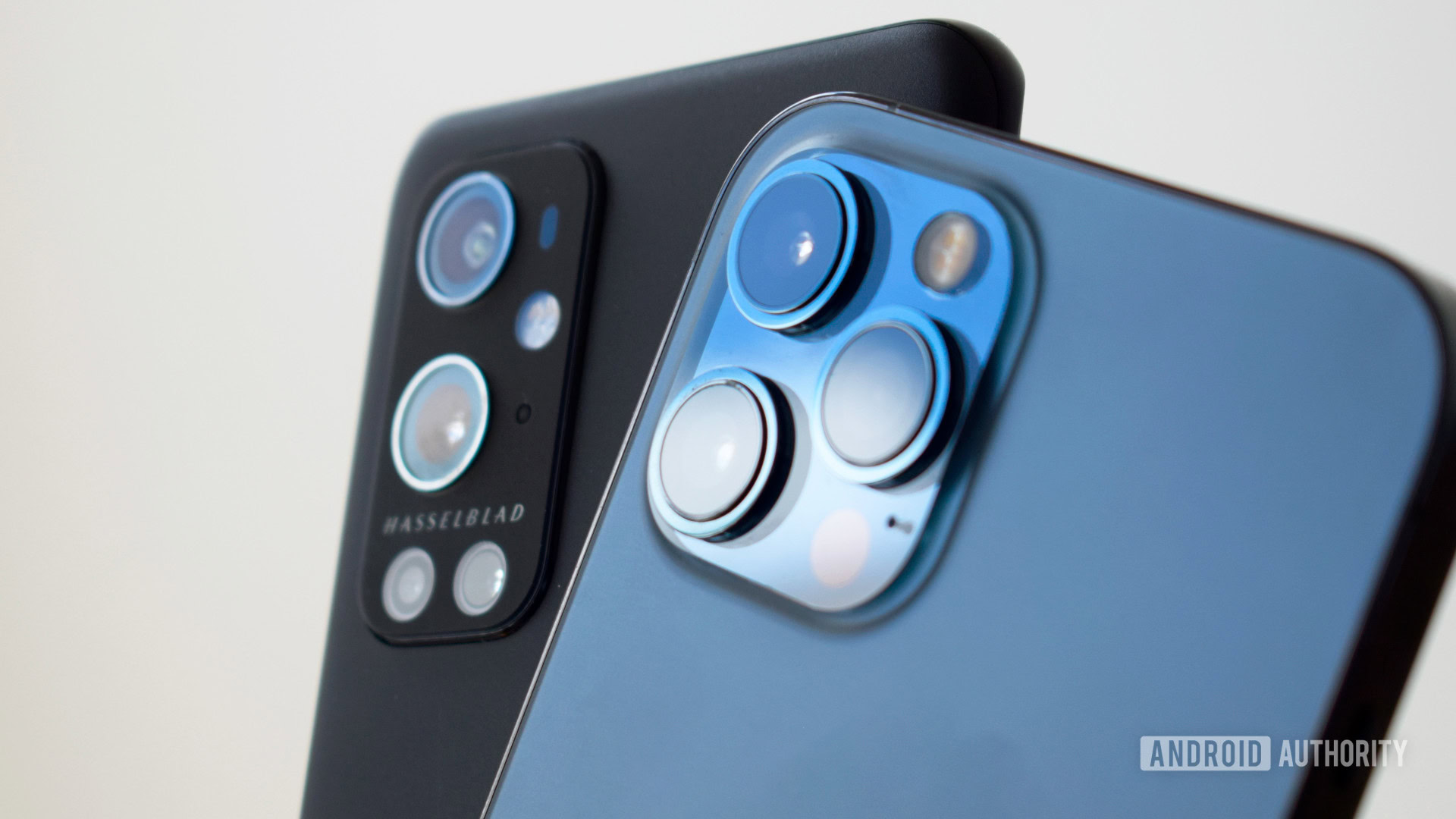
Solid cameras sell smartphones and iPhones have built a reputation for snapping great pictures — a reputation bolstered by its top-of-the-line 2020 device, the iPhone 12 Pro Max. Meanwhile, OnePlus has partnered with Hasselblad for this generation’s flagship smartphone, the OnePlus 9 Pro, to boost its own credentials and take on the best in the business.
These two handsets are on the more reserved end of the flagship camera spectrum. You won’t find any crazy periscope zoom cameras or gimmick lenses here. Both aim to perfect the tried and tested main, wide, and telephoto zoom formula. The aim of the game is great-looking pictures, first and foremost.
But which does it best? Let’s dive right on into our OnePlus 9 Pro vs Apple iPhone 12 Pro Max camera shootout. Oh, and feel free to check out the full-res image samples here.
OnePlus 9 Pro vs iPhone 12 Pro Max camera specs
| OnePlus 9 Pro | Apple iPhone 12 Pro Max | |
|---|---|---|
Main Camera | OnePlus 9 Pro 48MP (12MP binned) f/1.8 aperture 23mm focal length 1/1.43" sensor dual pixel PDAF, OIS | Apple iPhone 12 Pro Max 12MP f/1.6 aperture 26mm focal length dual pixel PDAF, IBIS |
Wide-angle | OnePlus 9 Pro 50MP (12.5MP binned) f/2.2 aperture 14mm focal length 1/1.56" sensor | Apple iPhone 12 Pro Max 12MP f/2.4 aperture 13mm focal length 1/3.6" sensor |
Telephoto zoom | OnePlus 9 Pro 8MP f/2.4 aperture 77mm focal length PDAF, OIS 3.3x optical zoom | Apple iPhone 12 Pro Max 12MP f/2.2 aperture 65mm focal length 1/3.4" sensor PDAF, OIS 2.5x zoom |
Focusing | OnePlus 9 Pro Laser AF system | Apple iPhone 12 Pro Max 3D ToF Lidar |
Selfie | OnePlus 9 Pro 16 MP f/2.4 aperture 1/3.06" sensor | Apple iPhone 12 Pro Max 12 MP f/2.2 aperture 23mm focal length 1/3.6" sensor |
Daylights, colors, and exposure
With large main sensors onboard, both smartphones take very good pictures in daylight. Few will have any complaints here, which is what we’ve come to expect from flagship-tier smartphones in the past couple of years. Although that isn’t to say that there aren’t noticeable differences between these two cameras. For starters, the shorter focal length means you’ll get a slightly wider field of view from the OnePlus 9 Pro’s main camera.
Despite its reputation for high-quality imaging, Apple applies a slight yellow tint to its photos. This is particularly noticeable on green grass and with indoor lighting, resulting in a more oversaturated look that’s not as nice as OnePlus’ realistic approach to colors. Otherwise, the iPhone continues to set a high bar for color accuracy and general imaging performance.
Our verdict: OnePlus 9 Pro review | Apple iPhone 12 Pro review
The OnePlus 9 Pro’s main camera is also mostly spot on with color processing. Saturation is very good without being too strong, although this can leave some scenes looking a little too washed out. What’s more noticeable is that the phone’s HDR algorithm tends to leave blue skies with an unrealistic purple hue. You can also notice some chromatic aberration (purple halos) around the tree branches in the image below and some lens flare, which is indicative of an inferior lens.
Both phones do a decent job when it comes to exposure and white balance. However, the iPhone 12 Pro Max regularly slightly underexposes compared to the OnePlus 9 Pro. You can see in the shadows of most of the images above where the iPhone has much darker shadows. It’s almost like a fake high-contrast HDR effect, but it detracts from the camera’s realism.
Detail
Detail and noise have historically let OnePlus down, but there are again noticeable improvements this generation. Despite the sensor resolution differences, the two phones capture 12MP images. So differences in detail will come down to how well the sensors capture light and how the software processes this detail.
Photography terms explained: ISO, aperture, shutter speed, and more
Broadly speaking, both phones capture solid-looking details at full frame. There’s really nothing to tell the two apart at a glance. Peeping closer, the two are keen to apply a touch of denoise and sharpening to their images. Neither is as naturally soft-looking as a DSLR, particularly with fine edges like tree branches and complex textures such as brickwork.
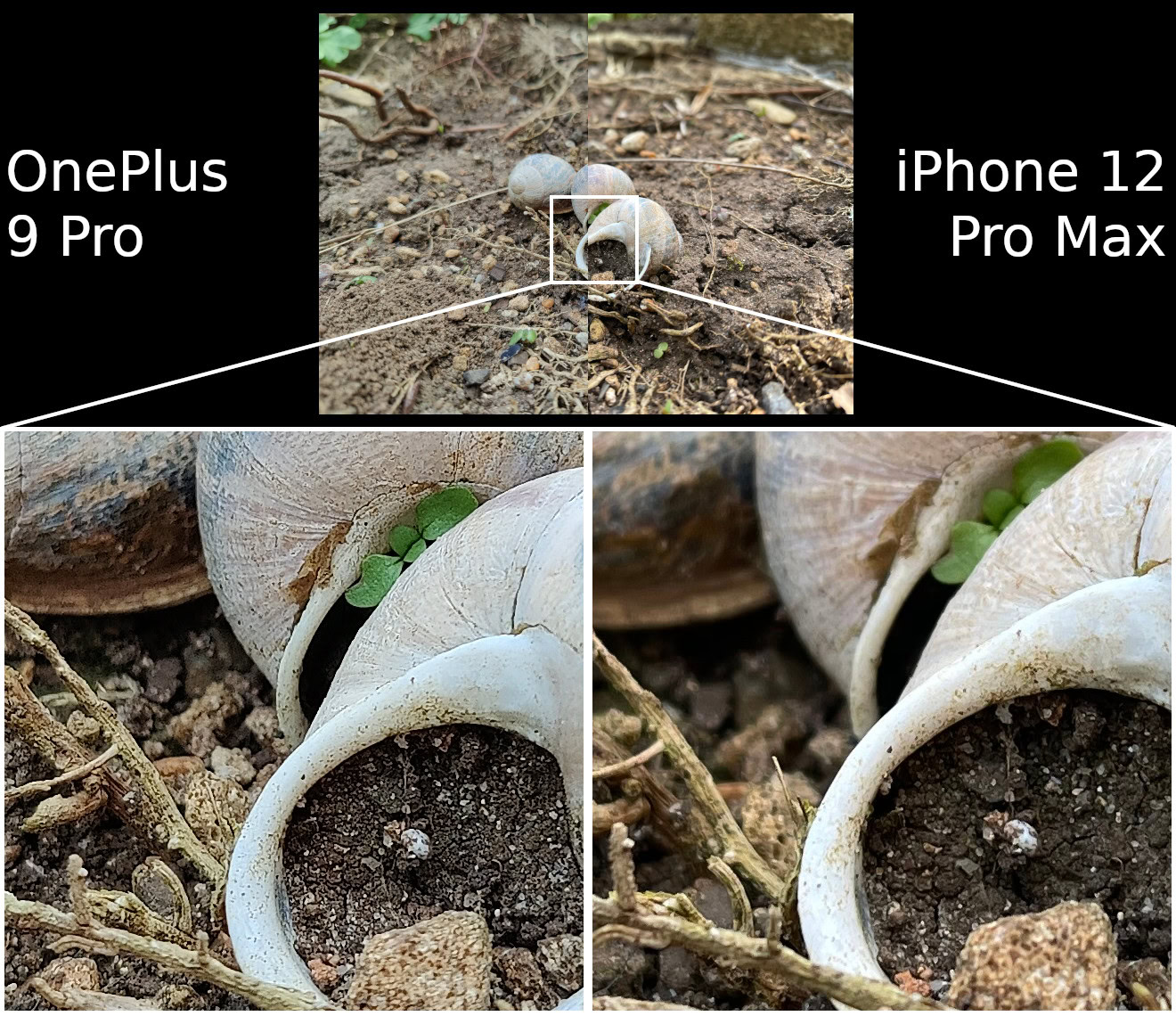
However, the OnePlus 9 Pro is definitely the more heavy-handed here. The phone’s preference for oversharpening results in much harsher edges and highlights when cropping in and editing. It’s not overbearing enough to ruin full-frame pictures but is definitely something to consider if you’re a fan of photo editing. Overall, Apple’s slightly softer approach produces better-looking details.
HDR capabilities
There’s a much more noticeable difference between the OnePlus 9 Pro and Apple’s iPhone 12 Pro Max when it comes to more difficult HDR scenes. To cut to the chase, HDR is a major weakness for the iPhone while OnePlus has one of the more powerful implementations in the business.
The examples above showcase a typical compromise with the iPhone when shooting against a strong backlight. You either end up with an underexposed foreground or overexposed background highlights and a loss of detail. The OnePlus 9 Pro is by far the superior phone here and can capture much more from its HDR images.
HDR isn’t just about shadows and highlights, though. The iPhone’s comparatively poor HDR implementation also leaves colors looking washed out, as the above example showcases perfectly. The phone warmer tint doesn’t help here either.
There's no arguing here, OnePlus provides a far superior HDR implementation
OnePlus’ HDR implementation isn’t completely free from clipping, but it does a mostly excellent job of making the most tricky lighting conditions. There’s really no contest between the two, so chalk this up as a major win for OnePlus over Apple.
Shooting in low light
Turning down the lights reveals yet more key differences between the two smartphones. Although the OnePlus 9 Pro and iPhone 12 Pro Max both support night mode shooting options, the results are quite different.
Before we get to Night modes though, let’s look at some lower light samples. Both hand it reasonable results with decent levels of detail, white balance, and colors. In the first example, Apple’s phone pumps up the exposure and saturation. However, turning the lights down lower in the second image below sees the iPhone 12 Pro Max struggle with exposure and colors much more noticeable than the OnePlus.
Switching to night mode shots showcases some bigger differences. With reasonable lighting, both phones do OK. Colors and exposure are good, but again the iPhone offers a warmer appearance. However, even in the first image below we can see a small detail and dynamic range advantage for the OnePlus 9 Pro.
Turning to a very low light shot reveals the length that the OnePlus 9 Pro will go to to obtain decent exposure. There’s a high amount of grain, partly from a very high ISO figure, but Bender is far better illuminated than the iPhone with more noticeable detail. That said, the highlight clipping isn’t great and Apple’s handset definitely has a cleaner appearance and is the more realistic, giving the lighting conditions.
Overall, both phones are a mixed bag in low light. Apple definitely underperforms without Night mode, with colors becoming washed out in lower lighting. However, OnePlus’ Nightscape shots often end up very noisy compared to better lowlight phones like the Pixel 5 and Galaxy S21 Ultra.
Related: 6 tips for improving smartphone low light photography
Zooming in on details
With 3.3x and 2.5x telephoto cameras onboard, the OnePlus 9 and iPhone 12 Max aim to offer improved picture quality at reasonable zoom levels. The iPhone 12 Pro Max looks to have a small hardware advantage on paper, but OnePlus is set to offer longer-range capabilities. But with such small image sensors, processing that’s likely to be the bigger differentiator.
Both phones provide very flexible shooting configurations. Their wide-angle lenses offer a large step back from the main lens. Meanwhile, both telephoto lenses hold up OK to 3x and even slightly beyond.
The first example really showcases the strengths and weaknesses of OnePlus’ latest zoom arrangement. At 2x and 3x, the 9 Pro looks good at full-frame but showcases noticeable processing artifacts on closer inspection. It looks like the shots are taken straight from the main image sensor, pre-binning.
The OnePlus 9 Pro boasts vastly improved detail over the iPhone 12 Pro Max at longer zoom levels. However, the level of chromatic aberration is pretty unacceptable for such typical daylight conditions. It’s an indicator of another poor quality lens. The iPhone 12 Pro Max has no such issues, but this first batch of zoom images all lean far too heavily on denoise and sharpening to look good.
Despite shooting in almost perfect outdoor conditions, both phones also struggle with this zoomed-in landscape shot. Apple’s handset lacks virtually any detail in the distant tree textures even when zooming in at 2x and 3x. The 5x and 7x shots are basically unusable.
It’s the same story as before for the OnePlus 9 Pro. It retains superior details to the iPhone at all zoom levels, which becomes more noticeable at longer ranges. However, once the telephoto camera kicks in beyond 3.3x, light capture and colors take a nosedive. The underexposed purple hue is very poor but sadly a common theme for OnePlus latest zoom camera. Again the 5x and 7x shots are throwaways.
Neither offers particularly compelling zoom capabilities for flagship-tier phones
In summary, neither smartphone offers particularly compelling zoom capabilities for flagship-tier handsets. The OnePlus 9 Pro nudges ahead in terms of detail at longer zoom levels, but the iPhone 12 Pro Max fairs better with color balance consistency.
Wide-angle lenses
With the OnePlus 9 Pro boasting a 14mm wide-angle lens and the Apple iPhone 12 Pro a 13mm focal length, the two offer a major step back from their main sensors. Apple’s version is technically a fraction wide than OnePlus’ and provides a bigger step back from its main sensor. But in reality, you end up with an essentially identical field of view between the two.
Both phones take on a slightly more yellow hue in the image above. Although the iPhone 12 Pro Max does a better job matching the color profile between its main and wide-angle lenses. Wide-angle pictures come out much warmer on the OnePlus 9 Pro versus its main sensor.
Other than the color profile, there’s not a huge amount of difference between the two wide-angle lenses. The two phones keep edge distortion reasonably under control and are both definitely solid wide-angle shooters. You have to crop at 100% to make out differences in detail.
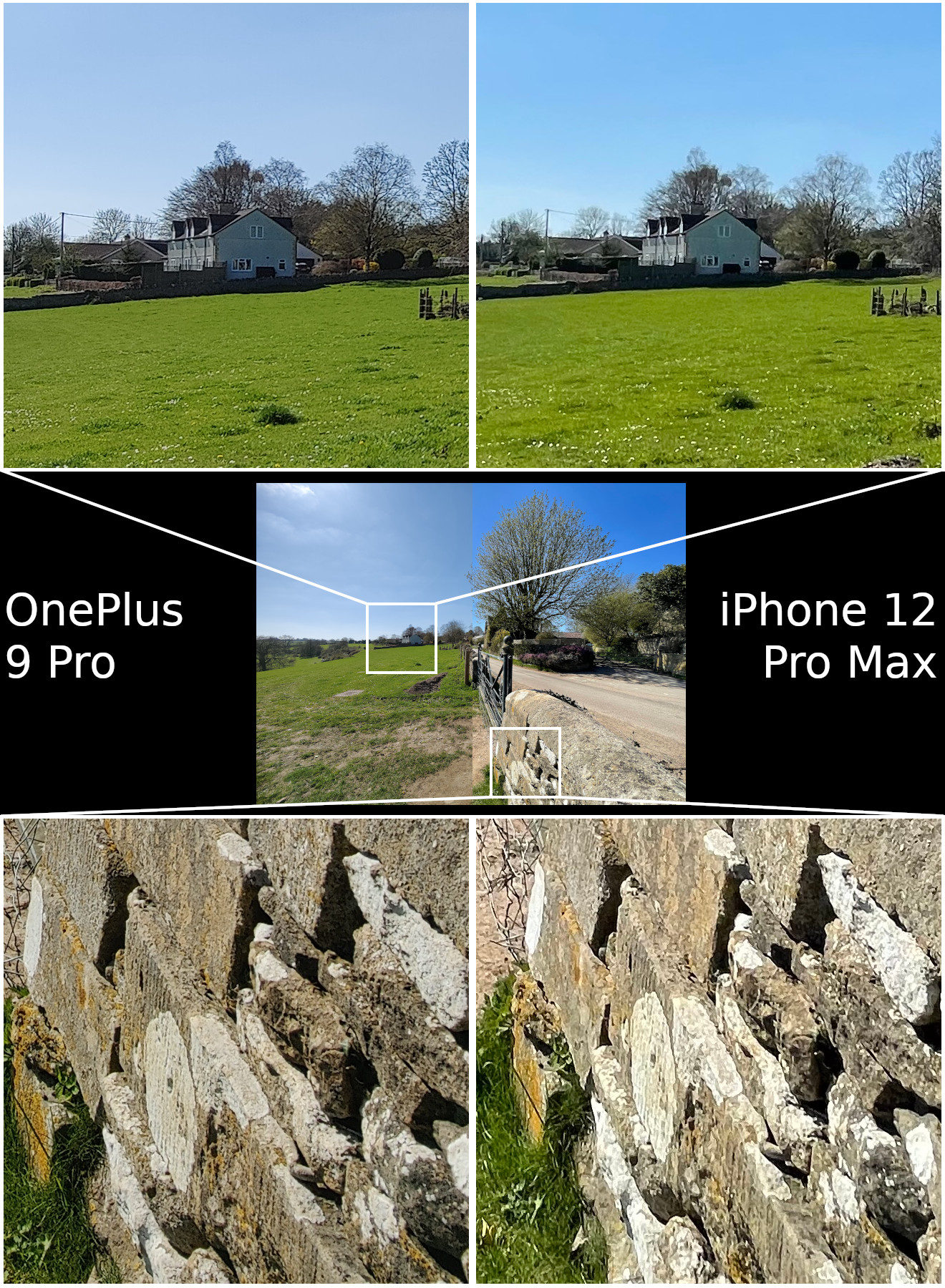
The OnePlus 9 Pro’s larger 1/1.56-inch sensor does a marginally better job at detail capture versus Apple’s smaller 1/3.6-inch sensor. See the trees, grass texture, and brickwork in the example above. Apple is more reliant on post-processing to clean up its wide-angle images. That said, few users will blow up and crop their wide-angle pictures, so OnePlus’ small detail advantage here is unlikely to mean much to most consumers.
Bokeh and portraits
If you love a good selfie, you’ll be pleased to note that the OnePlus 9 Pro and iPhone 12 Pro Max offer a selection of filter and bokeh blur options with their front-facing camera. The two offer wide field of view capabilities to fit more in. However, Apple defaults to a slightly narrower lens by default, as you can see below.
Both smartphones hand in excellent-looking selfies in bright outdoor conditions. You’ll find ample skin texture and tones as well as decent-looking bokeh blur if you like that look. However, Apple tends to warm up skin colors a little too much in the example above, producing a bit of a red tint. I definitely haven’t had enough sun this year to get a tan.
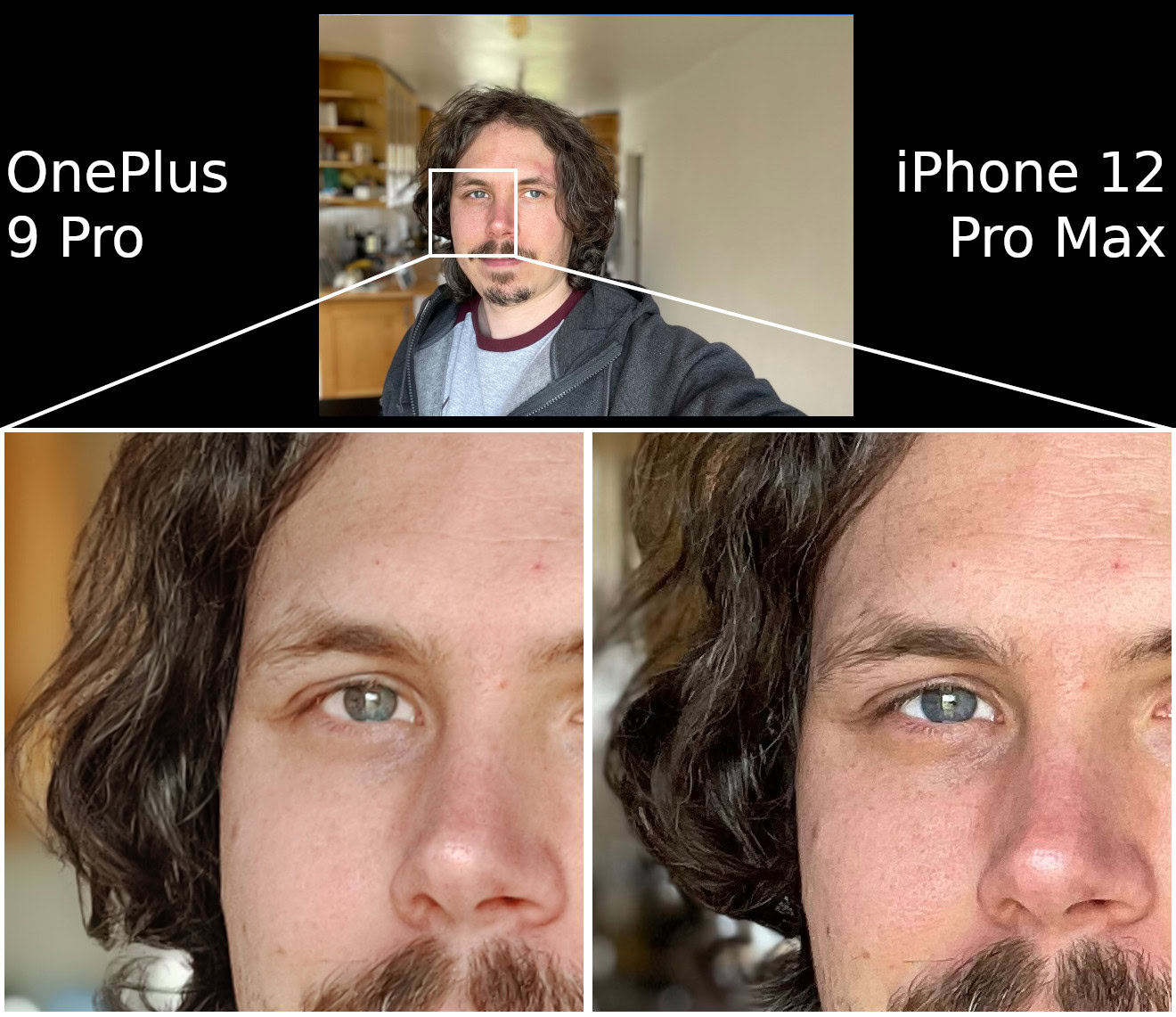
Moving indoors, the OnePlus 9 Pro doesn’t hand in quite so good-looking selfie results. Skin textures and details become softer and noise also creeps in once the lights go down further. The iPhone 12 Pro Max holds up much better with indoor lighting, although it doesn’t perform as well as the OnePlus at edge detection for bokeh blur.
Both smartphones offer bokeh blur with their rear cameras too. Typical color and exposure differences aside, both phones hand in pretty nice looking blur results. There’s a gentle gradient from the foreground to the background that ensures pictures from the two handsets offer a natural-looking blur. Although I think Apple’s algorithm introduces ‘sparkle spots’ too aggressively, as the level of blur doesn’t quite match the camera’s focal length.
Apple’s bokeh blur certainly looks good but its edge detection leaves a lot to be desired. The hair example above is perhaps the best example of the subtle but important differences between the OnePlus 9 Pro and iPhone 12 Pro Max when it comes to accuracy.
These two take solid selfies and portraits. I’ll give Apple the nudge on detail, but OnePlus offers superior edge detection and tone accuracy.
OnePlus 9 Pro vs Apple iPhone 12 Pro Max camera test: The verdict
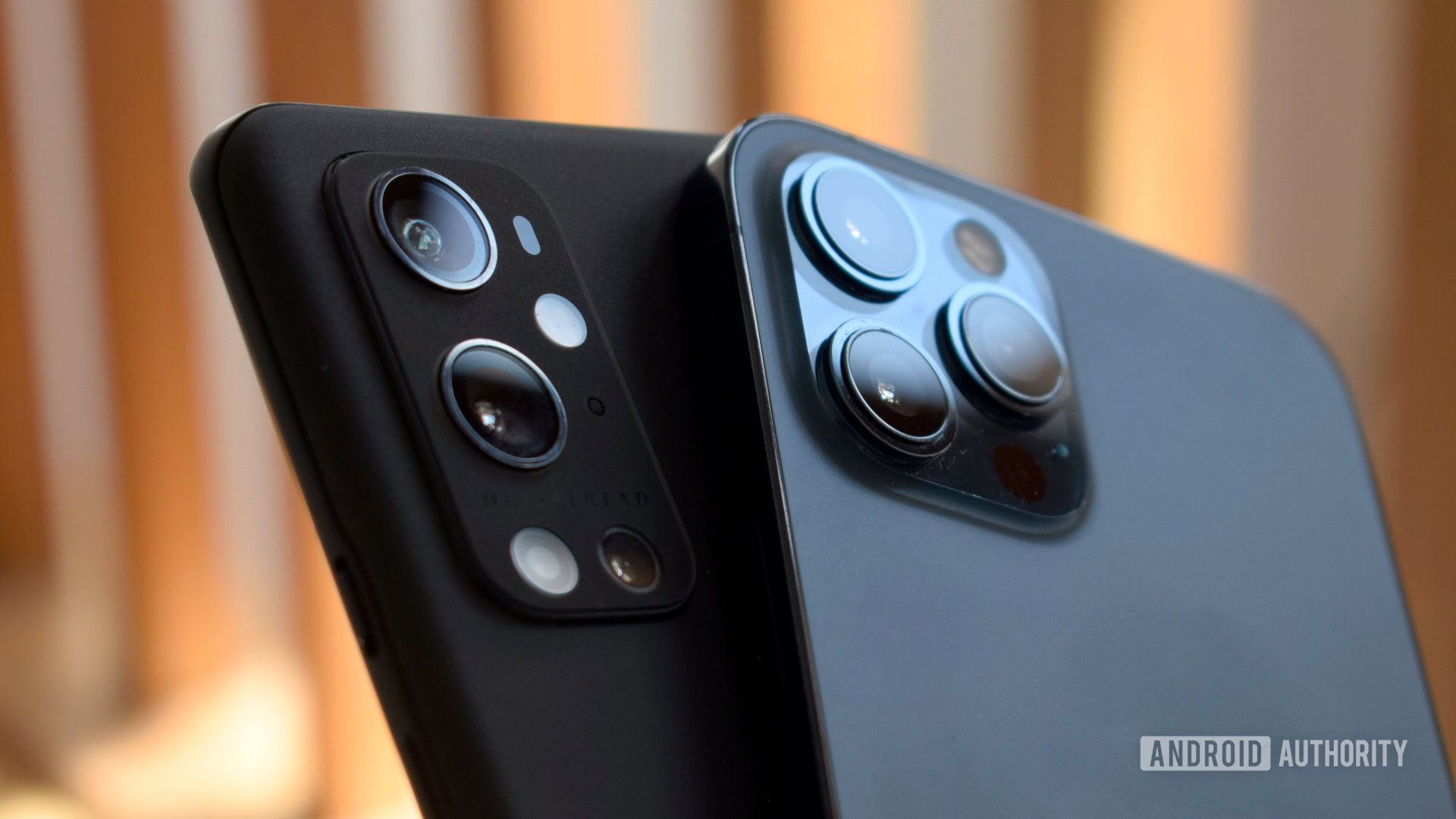
This is certainly one of the closest camera shootouts I’ve undertaken in recent months. The OnePlus 9 Pro and iPhone 12 Pro Max both have some very notable pros and cons.
If you’re looking for a definitive verdict. I’d say the best pictures in this shootout come from the OnePlus 9 Pro. That’s quite an accomplishment when you consider that the OnePlus 9 Pro costs $130 less. However, the 9 Pro also takes some of the worst pictures of the two. It’s much more inconsistent than the iPhone, which rarely takes a completely terrible image.
Which phone takes the better pictures?
If it weren’t for the purple tint, the OnePlus 9 Pro would come out ahead for color accuracy, despite the lack of consistency across lenses. The phone scores a clearer win when it comes to bokeh accuracy and, more importantly, HDR environments. The latter really is the bread and butter of modern smartphone photography. OnePlus’ latest camera setup is far from flawless, though. Zoom quality is a hot mess, and even general images can look a little oversharp.
Check out more camera shootouts:
- OnePlus 9 Pro vs Samsung Galaxy S21 Ultra camera shootout
- Samsung Galaxy S21 Ultra vs iPhone 12 Pro Max
Apple clearly scores a couple of its own wins, capturing better selfie textures and more natural-looking details. But the phone’s tendency to apply warm and yellow hues undoes much of the good work on color accuracy. Both the iPhone and OnePlus are also subpar in the zoom and low light departments. That said, these are two top-tier camera phones that can happily hang with the very best.
That’s it for our OnePlus 9 Pro vs Apple iPhone 12 Pro Max camera shootout. Let us know your thoughts on the images in the comments.